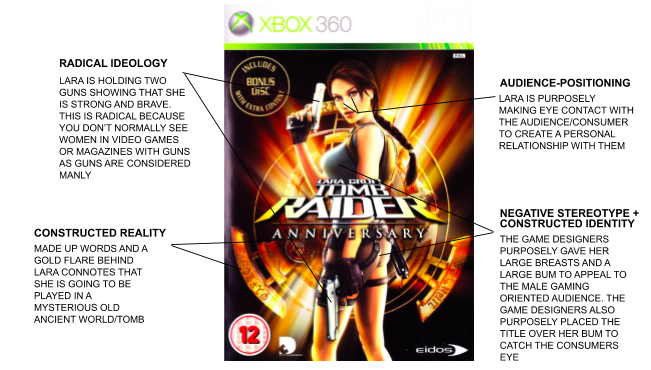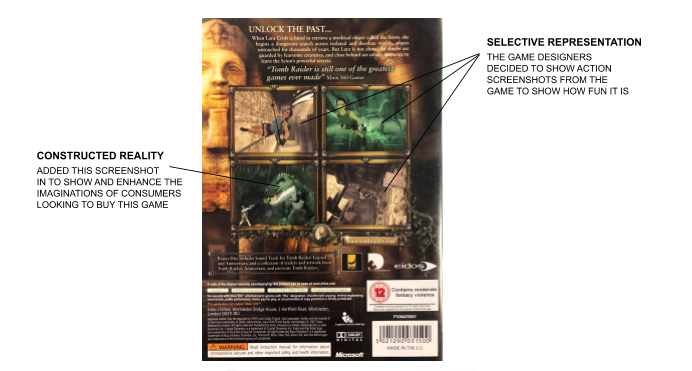When placing Tomb Raider, a video game and Men’s Health, a magazine, against each other, you can tell that these two pieces of text are very much different from each other due to the codes and conventions we associate them both with when identifying what a product is. What makes these two texts especially different from each other are the representations of gender stereotypes. Men’s Health is a reactionary piece due to it having on the front cover Vin Diesel, a man who is meant radiate masculinity and have the ideal male anatomy in today’s society compared to Tomb Raider who yes, does have the big boobs and big butt which in today’s society, does expect and like but is also a character who is a female excursionist that fights multiple monsters and dinosaurs and goes on adventures raiding multiple tombs, caves and forests etc making Tomb Raider a radical piece.
Lara Croft blew up gaming culture in 1996 with the first instalment of Tomb Raider. But for some reason, her character has been so predominantly defined by her sex appeal that two decades on, we’re still trying to start conversations about her breasts and arse creating a negative stereotype towards women as the game then sets expectations on how women should look then misrepresenting them, even though, Lara crofts body is so artificial that it would be impossible to recreate in real life, hence why it would be such a negative stereotype. Although ironically, Lara’s sex appeal is also what made her one of gaming’s most groundbreaking characters. If she’d been less “sexy”, she arguably couldn’t have gotten away with being the lead of a video game franchise — and that was huge. Aside from 1981’s Ms. Pac-Man and a twist ending of Nintendo’s 1986 game Metroid that revealed the lead character to have been a woman all along, major game franchises basically didn’t have playable female characters as their leads at that point in the medium’s history. So Lara was, in at least one sense, an extraordinary example of female empowerment. It was rare enough that she helmed a franchise in which players can only play as a woman — but that franchise was also a worldwide bestselling cultural phenomenon.


One of the most characteristic features of Men’s Health is the reiterated exposure of the male anatomy, since it is openly exposed to the readers from front page in order to be observed, admired, and consumed. This way, the body is treated in multiple ways, suggesting different male identities which present two main aspects in common; the cult of the athletic body in one hand and the acquisition of certain products to improve its appearance in the other hand. Taking this into account, the ways in which maleness is represented in MH are explained next through the metaphor of the bodies, due to the importance given to the male anatomy in the publication. Given what has been mentioned before, it is not strange that most experts in the field highlight the connection between the concepts of masculinity depicted in the magazines and the construction of men as consumers. Thus, it could be said that the renewals concerning what is understood as manly are subject to the constant changes taking place not only within fashion industry, but also within the whole market. In this sense, it is essential to note that, as a concept, the term masculinity is not fixed nor natural, but rather socially constructed, multiple, and, consequently, different depending on the culture, time and place. Therefore, from this point of view, the formulations and reformulations of maleness through time respond to a strategy to attract men as new purchasers. This new conception of men as consumers developed during the first half of the 20th century in the United States, where the roots of the current male lifestyle magazines are traced.

This all connects to David Gauntlett’s theories of identity. Gauntlett talks about how identity isn’t fixed and how it is more fluid in some ways. Because mass media today is so focused on being healthy, being slim and fit and being stable, a part of society may feel that these ideals that the magazines are proposing aren’t correct and are in fact, very wrong in some cases leading the people in this part of the society to feel that they should go against these norms and desires that mass media promotes. this leads people on a route of self expression which, most of the time, is very good because it helps others get to know themselves and helps them learn and know what and who they’re comfortable with. But, in very rare cases, some people who disagree with what mass media produces and promotes can take things in such a wrong way that it leads them to let out their anger and disagreement in violent ways, some even turn into extremists. This leaves me with the question, should we filter what we place in and on products of mass media? Would it get rid of these extreme views? Would society become almost robot like due to filtering specific articles out? There are many questions to go with “should we filter what we place in and on products on mass media” which I find great as it causes a discussion and really makes people think. Personally, I don’t feel like we should filter out specific articles as it would prevent people from finding and experimenting with their identity. I feel that society should more or less, learn how to deal with these extremists without bullying or violence although I know this can be very difficult to achieve as its basically human nature to diss something we don’t like, but hey, I’m just a gen z with the so-called Peter Pan syndrome so why should my opinion matter.
